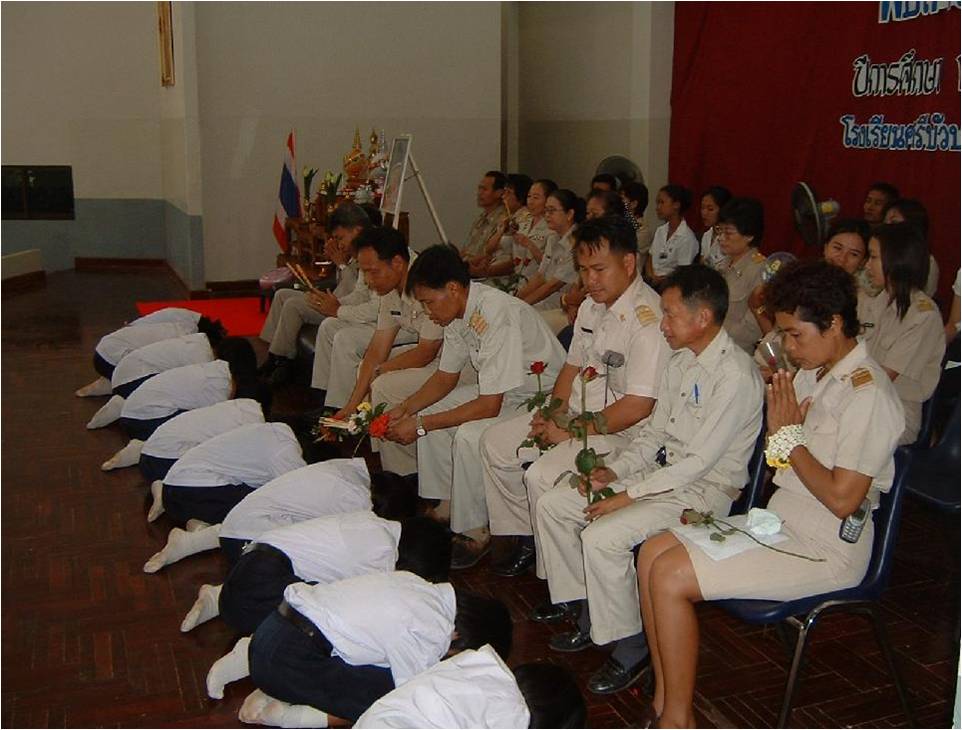Our school is people.

Wai Kruu Day
An annual formal ceremony where students show traditional respect to their teachers. A day enjoyed by Thai students. This celebration occurs on the second Thursday of June.
We are in a part of Thailand with a history of civilisation dating back to ~100 CE (640 BE)* and some think that it may have been one of the earlier areas of civilisation along the middle Mekong. The ancient empire of Funan may well have been our first nation.
Our heritage is varied: Chinese, Lao(Dao), Tai(Dai), Vietnamese, Khmer and well represented are a number of "indigenous minorities" and we are all Thai Nationals.We share a common culture and we celebrate the diversity of each other's original cultures. We have foods, liquor, costume, music and dance unique to each group and our various handicrafts are quite distinctive for many of the groups. These handicrafts range from woven fabric, woven grasses, stone work, metal work and art.
Our school is a secondary school with classes from matium one to matium six, this is equivalent to western classes from the 7th year to the 12th year. We are taught by 30 teachers and we number 00 students, boys and girls.
Isaan literally means the North East. Traditionally we have spoken our own dialect which was a variant of the Lao language. This is because in past history our region was in the old kingdom(s) of Lao. In this generation the Lao language is being quickly replaced. Some would say sadly.
Our main food tends to be that associated with the Lao cuisine. There is not as much use of coconut cream well-known in the central Thai cooking but our food is delicious also. We eat a lot of glutinous rice and vegetables, some meat and fish from the river and fish farms. We enjoy our barbecued food very much and we like our food spicy, flavoured with chillie and garlic. In the west people traditionally use condiments like pepper and salt to add to the food on their plate. We tend to use a wet condiment called "naam phrik" or "jaio " to use the Lao word and this can be anyone of 300 different types. All naam phrik is spicy and salty. It is a different way of adding the final flavour to food.
Every Isaan person enjoys Laap which is a Lao original food (maybe even Khmer) and today is seen as a signature dish for Isaan and Laos. This can be based on vegetable or meat or fish. The meat and fish kinds can be raw and then they are called Tiger Laap, not so common and more popular with our grandparents for special occassions. Laap typically can be minced meat that is cooked quickly but completely in an open pot. It is then mixed with chillie, lime juice, fish sauce and dry roasted rice powder. It is served with fresh green vegetables and sticky-rice and traditionally eaten with the fingers. If you come to Isaan it is a dish you must try but please tell your cook not to make it too spicy! Many westerners can enjoy a half a chillie in their plate of Laap but Isaan people have been seen to eat 10 or even 20 chillies in their Laap!
Isaan people enjoy family, music, singing and dancing very much. It makes us happy and relaxed with our friends. We sing a lot and dance traditional dances a lot. We also enjoy pop music often performing variations of traditional dance with this kind of music. It works well and everyone gets involved. We try to celebrate festivals as often as we can and have parties the rest of the time :) Our cultural identity is very familiar to all and easily defined by all Isaan people. Many Isaan people will answer the question where are you from with "I am Lao". This doesn't mean they are Lao nationals it means they are ethnic Lao and Thai nationals and very proud of their nationality and cultural heritage.
Sribuaban is a rural community near the city of Nakhon Panom. We are at a rural-urban interface and familiar with much of the urban world. Our nearby city of Nakhon Panom is developed and modern. We are very familiar with most western peoples as there are many tourists and many Thai-Falang marriages here and in fact all over Thailand, but we are very shy. Falang is a friendly term used to identify white europeans. It comes from an old Lao word meaning potato or guava and sounded to the ears of our ancestors like the word for "France", the country of origin of the first western people seen in this part of the world.
*The Buddhist Era (BE) precedes the Christian Era (CE) by 543 years. So as an example the CE year 2009 would be 2552 BE




